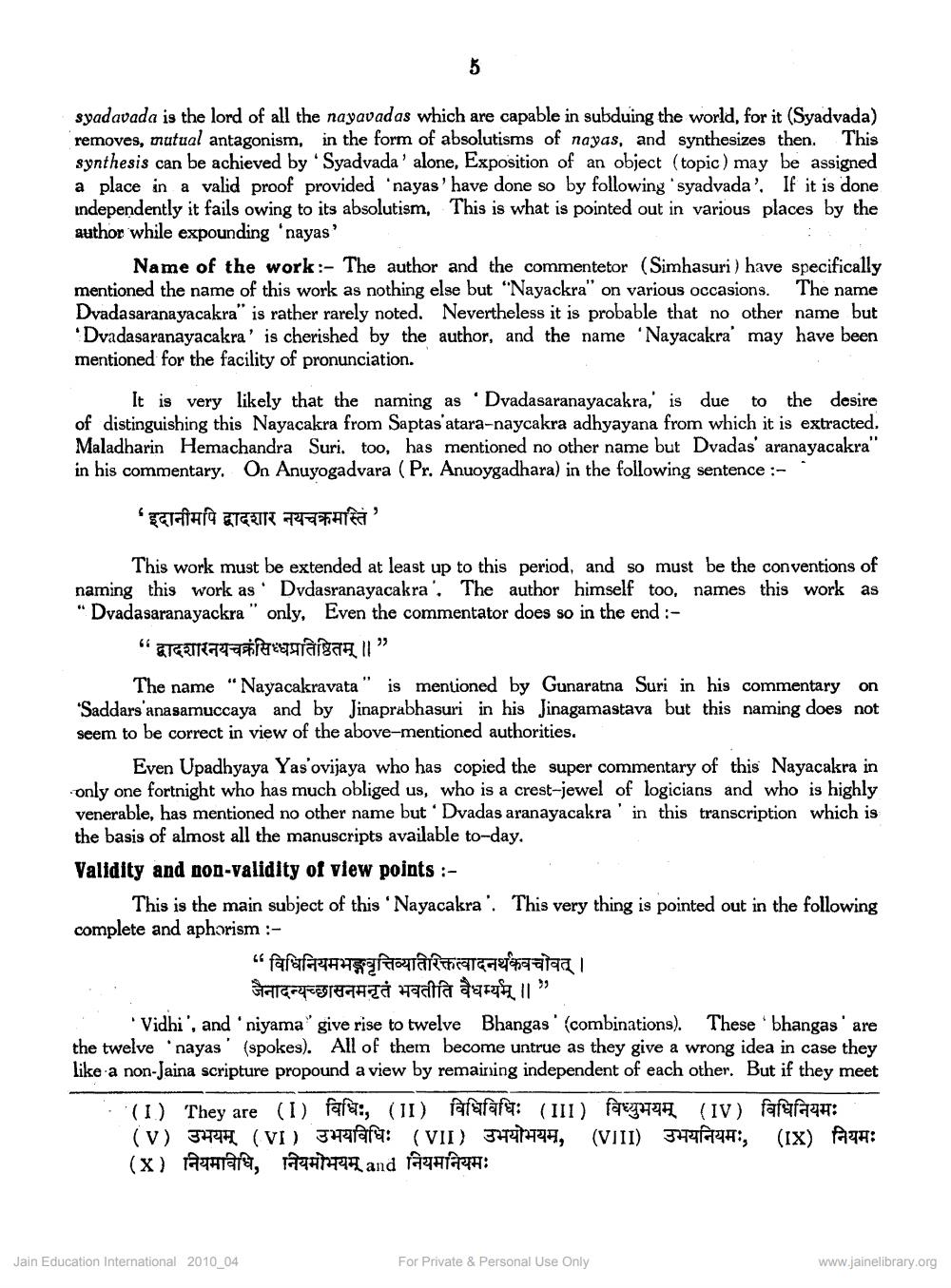________________
5
syadavada is the lord of all the nayavadas which are capable in subduing the world, for it (Syadvada) removes, mutual antagonism, in the form of absolutisms of nayas, and synthesizes then. This synthesis can be achieved by 'Syadvada' alone, Exposition of an object (topic) may be assigned a place in a valid proof provided 'nayas' have done so by following 'syadvada'. If it is done. independently it fails owing to its absolutism, This is what is pointed out in various places by the author while expounding 'nayas'
Name of the work:- The author and the commentetor (Simhasuri) have specifically mentioned the name of this work as nothing else but "Nayackra" on various occasions. The name Dvadasaranayacakra" is rather rarely noted. Nevertheless it is probable that no other name but 'Dvadasaranayacakra' is cherished by the author, and the name 'Nayacakra' may have been mentioned for the facility of pronunciation.
It is very likely that the naming as Dvadasaranayacakra, is due to the desire of distinguishing this Nayacakra from Saptas atara-naycakra adhyayana from which it is extracted. Maladharin Hemachandra Suri. too, has mentioned no other name but Dvadas' aranayacakra" in his commentary. On Anuyogadvara (Pr. Anuoygadhara) in the following sentence :
'इदानीमपि द्वादशार नयचक्रमस्ति '
This work must be extended at least up to this period, and so must be the conventions of naming this work as Dvdasranayacakra. The author himself too, names this work as "Dvadasaranayackra" only, Even the commentator does so in the end :
" द्वादशारनयचक्रं सिध्धप्रतिष्ठितम् ॥”
The name "Nayacakravata" is mentioned by Gunaratna Suri in his commentary on 'Saddars anasamuccaya and by Jinaprabhasuri in his Jinagamastava but this naming does not seem to be correct in view of the above-mentioned authorities.
Even Upadhyaya Yas'ovijaya who has copied the super commentary of this Nayacakra in only one fortnight who has much obliged us, who is a crest-jewel of logicians and who is highly venerable, has mentioned no other name but Dvadas aranayacakra' in this transcription which is the basis of almost all the manuscripts available to-day.
Validity and non-validity of view points :
This is the main subject of this 'Nayacakra. This very thing is pointed out in the following complete and aphorism :
“ विधिनियमभङ्गवृत्तिव्यतिरिक्कत्वादनर्थकय चोवत् । जैनादन्यच्छासनमनृतं भवतीति वैधम्र्म्यम् ॥ "
Vidhi", and "niyama" give rise to twelve Bhangas (combinations).
These 'bhangas' are
the twelve 'nayas' (spokes). All of them become untrue as they give a wrong idea in case they like a non-Jaina scripture propound a view by remaining independent of each other. But if they meet
Jain Education International 2010_04
(1) They are (1) faf, (11) fafafafa: (111) f (IV) (V) उभयम् (VI) उभवविधिः (VII) उभयोभयम, (VIII) उभयनियमः, (x) नियमविधि, नियमोभयम् and नियमनियमः
For Private & Personal Use Only
: ( IX ) नियमः
www.jainelibrary.org




